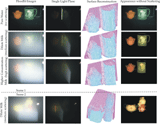
|
Virtually all structured light methods assume that the scene and the sources are immersed in pure air and that light is neither scattered nor absorbed. Recently, however, structured lighting has found growing application in underwater and aerial imaging, where scattering effects cannot be ignored. In this project, we conduct a comprehensive analysis of two representative methods - light stripe range scanning and photometric stereo - in the presence of scattering. For both methods, we derive physical models for the appearances of a surface immersed in a scattering medium. Based on these models, we present results on (a) the condition for object detectability in light striping and (b) the number of sources required for photometric stereo. In both cases, we demonstrate that while traditional methods fail when scattering is significant, our methods accurately recover the scene (depths, normals, albedos) as well as the properties of the medium. These results are in turn used to restore the appearances of scenes as if they were captured in clear air. Although we have focused on light striping and photometric stereo, our approach can also be extended to other methods such as grid coding, gated and active polarization imaging.
|
Publications
"Structured Light in Scattering Media"
S.G.
Narasimhan, S.K. Nayar, B. Sun and S.J. Koppal
IEEE International
Conference on Computer Vision (ICCV),
Oct, 2005.
[PDF]
"Structured Light Methods for Underwater Imaging: Light
Stripe Scanning and Photometric Stereo"
S.G. Narasimhan and S.K.
Nayar
IEEE/MTS Oceans,
September 2005.
[PDF]
|
Pictures
|
Videos
(Video Result Playlist)
 |
ICCV 2005 Video (use Apple Quicktime 6.0):
This video is a compilation of the main results of
this project (30 MB). (With narration)
|
 |
Light Stripe Range Scanning:
This video shows the recovery of the 3D structures of objects
immersed in a scattering medium using the light striping method developed for
scattering media (23 MB). (With narration)
|
 |
Photometric Stereo:
This video shows the recovery of surface normals, depths
and albedos of scene points using the photometric stereo algorithm developed for
scattering media (6 MB). (With narration).
|
|
Presentation
[PPT]
|
|